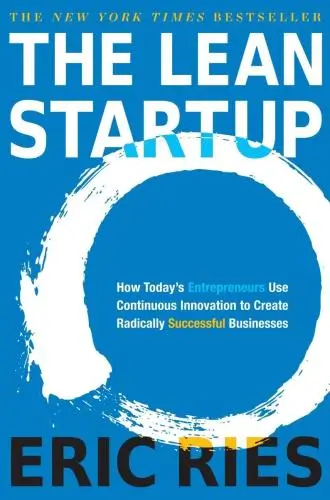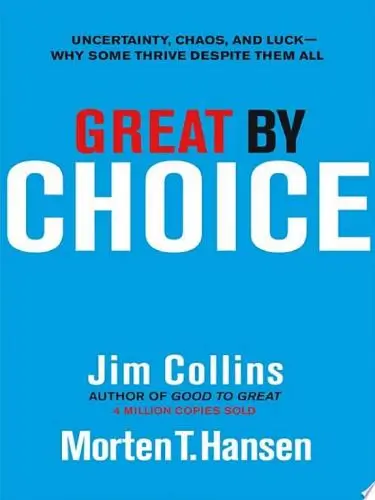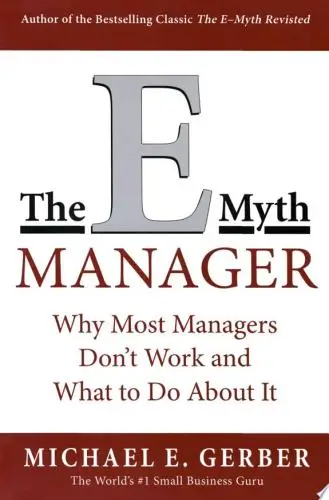
The Lean Startup
How Today's Entrepreneurs Use Continuous Innovation to Create Radically Successful Businesses
What's it about?
The Lean Startup is a guide for entrepreneurs looking to launch successful businesses in a fast-paced market. Eric Ries introduces the concept of validated learning, which emphasizes the importance of testing ideas quickly and efficiently to minimize risks. By focusing on iterative development and continuous innovation, startups can adapt to customer feedback and pivot when necessary.
About the Author
Eric Ries is an entrepreneur and author known for his groundbreaking book "The Lean Startup." He advocates for a scientific approach to creating and managing successful startups, emphasizing rapid experimentation, validated learning, and a focus on customer feedback. Ries's work revolutionizes traditional business practices, challenging entrepreneurs to adapt and innovate in the fast-paced world of startups.
10 Key Ideas of The Lean Startup
Embrace the Build-Measure-Learn Feedback Loop for Continuous Innovation
This tactic involves rapidly turning ideas into products, measuring how customers respond, and then learning whether to pivot or persevere.
The key is to minimize the time through this loop.
Start by building a Minimum Viable Product (MVP) that is the simplest version of your idea capable of testing a hypothesis.
Measure its effectiveness using actionable metrics rather than vanity metrics to get a true sense of customer interest.
Based on this data, decide whether to pivot (make a fundamental change to the product) or persevere (continue with the current strategy).
This process helps in quickly identifying what works and discarding what doesn’t, significantly reducing wasted time and resources.
Learn DeeperStart Small: Begin by identifying a core feature or aspect of your idea that you believe is essential. This becomes the basis for your Minimum Viable Product (MVP).
Create Your MVP: Develop the simplest version of your product that allows you to test your hypothesis. Remember, the goal is not perfection but learning.
Define Actionable Metrics: Before launching, decide on specific, measurable outcomes that will indicate success or failure. Avoid vanity metrics like page views or downloads, unless they directly correlate to your goals.
Launch and Measure: Introduce your MVP to your target audience. Use the metrics you've defined to gather data on how users are interacting with your product.
Analyze and Decide: With the data in hand, take a hard look at what it's telling you. If you're not meeting your goals, consider whether a pivot is necessary. If you're on the right track, identify ways to further refine and improve.
Iterate Quickly: Based on your analysis, make the necessary adjustments to your product or strategy and repeat the process. The faster you can move through these steps, the quicker you'll find a successful formula.
- Example
A tech startup develops a new app aimed at helping people manage their time more effectively. They start with a simple MVP that includes just one or two key features, such as a daily planner and task prioritization. After launch, they measure user engagement and retention rates, finding that while the daily planner is popular, the task prioritization feature is not. They decide to pivot by enhancing the planner and removing the less popular feature.
- Example
A small online retailer wants to increase sales through a recommendation engine. They implement a basic version that suggests products based on items in a customer's shopping cart. They track conversion rates from the recommendations and discover that the feature significantly increases sales. Encouraged by this success, they decide to persevere with this strategy and invest in improving the recommendation algorithm.
Implement Continuous Deployment to Accelerate Product Development
Continuous deployment is a practice where every code change goes through the entire pipeline and is automatically deployed to production, resulting in many production deployments every day.
This approach allows teams to reduce development cycles, increase deployment frequency, and release features more quickly to users.
It encourages smaller, more manageable changes that are easier to troubleshoot and reduces the risk associated with large, infrequent releases.
By getting immediate feedback from users, teams can quickly address issues and adapt the product, leading to higher quality and more user-centric outcomes.
Learn DeeperStart Small: Begin by automating the deployment of small, non-critical features. This helps you get comfortable with the process and tools without risking major disruptions.
Automate Testing: Implement automated testing to ensure that every code change is vetted for bugs and issues before it reaches production. This step is crucial for maintaining quality.
Foster a Culture of Continuous Feedback: Encourage your team to actively seek out and respond to user feedback. Make it a regular part of your development cycle to review user comments and analytics.
Iterate Quickly: Use the insights gained from continuous deployment and user feedback to make rapid iterations on your product. Don't be afraid to pivot or make changes based on what you learn.
Monitor Performance Religiously: Set up monitoring tools to track the performance of your application in real-time. This will help you quickly identify and rectify any issues that arise post-deployment.
- Example
A social media startup uses continuous deployment to roll out new features like photo filters and story functions. They release updates weekly, allowing them to quickly gauge user interest and adjust based on feedback.
- Example
An e-commerce platform implements continuous deployment for their recommendation engine. By making frequent, small adjustments based on user behavior, they're able to refine their algorithms and improve product suggestions, leading to increased sales.
Use Split Testing to Make Informed Decisions
Split testing, or A/B testing, involves comparing two versions of a product or feature to see which one performs better.
By directing a portion of users to each version, you can collect data on user engagement, conversion rates, and other key metrics.
This empirical approach to decision-making helps eliminate guesswork and biases, allowing you to make informed choices based on actual user behavior.
Split testing can lead to incremental improvements that, over time, significantly enhance the overall user experience and product effectiveness.
Learn DeeperIdentify Key Metrics: Before you start split testing, pinpoint the metrics that matter most to your product or feature. This could be anything from user engagement time, conversion rates, or click-through rates on a specific button.
Create Two Variants: Design two versions (A and B) of your product or feature that differ in one key aspect you want to test. This could be a change in the call-to-action button color, the placement of a sign-up form, or the wording of a headline.
Segment Your Audience: Divide your audience randomly but equally to ensure that each group is statistically similar. This way, the results you get will be more reliable and indicative of true performance differences.
Run the Test Simultaneously: Launch both versions at the same time to ensure that external factors affecting one test group also affect the other. This helps in maintaining the integrity of your test results.
Analyze and Implement: After collecting sufficient data, analyze the results to see which version performed better based on your key metrics. Use these insights to make informed decisions and implement the winning strategy across the board.
- Example
An e-commerce website testing two different homepage designs to see which one leads to higher sales. Version A features a large, prominent sales banner at the top, while Version B uses a more subtle approach with recommended products front and center.
- Example
A mobile app developer testing two onboarding processes to determine which one results in higher user retention. Version A takes a minimalist approach, asking for only essential information, whereas Version B provides a more detailed tutorial on using the app.
Focus on Actionable Metrics Over Vanity Metrics
Actionable metrics are those that directly inform decision-making and indicate clear actions to be taken.
In contrast, vanity metrics (like total number of downloads or page views) might look good on paper but don't necessarily correlate with the factors that drive a business forward.
By focusing on actionable metrics, such as engagement rates, conversion rates, and customer acquisition costs, businesses can gain insights into what's working and what's not.
This focus enables more targeted improvements and helps allocate resources more effectively.
Learn DeeperIdentify Your Key Metrics: Start by identifying which metrics are most important for your business. Think about what actions or outcomes are critical for your success. For instance, if you're running an online store, conversion rate might be a key metric, while for a subscription service, monthly recurring revenue and churn rate could be vital.
Set Up a Dashboard: Use tools like Google Analytics, Mixpanel, or a custom dashboard to track these metrics in real-time. This will help you keep an eye on how changes in your product or marketing strategies affect these numbers.
Regularly Review and Act: Schedule regular review sessions (weekly or monthly) to go over these metrics. Look for trends, patterns, or sudden changes. Use this data to decide what to do next. For example, if you notice a drop in engagement, you might need to update your content or interface.
A/B Testing: Implement A/B testing to directly measure the impact of changes. For instance, if you're unsure whether a new feature will improve user engagement, create two versions of your product (one with the feature and one without) and measure the difference in engagement between the two groups.
Feedback Loops: Incorporate customer feedback into your metric analysis. Sometimes numbers don't tell the whole story. Direct feedback can provide context to the data, helping you understand why certain metrics are changing.
- Example
A mobile app developer notices that while downloads are high, daily active users (DAU) are low. They decide to focus on improving user engagement by tracking session length and frequency of use. By introducing features suggested by user feedback and observing the impact on these actionable metrics, they manage to increase DAU.
- Example
An e-commerce site observes through their dashboard that while traffic is steady, the conversion rate is declining. They conduct A/B testing on different checkout processes and discover that a simplified checkout increases conversions. They implement this change across the site, directly addressing the issue highlighted by their actionable metrics.
Pivot or Persevere: Making Strategic Shifts Based on Learning
The decision to pivot or persevere is critical in the lean startup methodology.
A pivot involves making a fundamental change to the business model or product direction based on feedback and learnings.
It’s not about abandoning the vision but rather finding a new path to achieve it.
Persevering means staying the course, refining and improving the current strategy.
This decision should be made based on rigorous analysis of actionable metrics and customer feedback, ensuring that the company is always moving in the most promising direction.
Learn DeeperRegularly Review Your Business Metrics: Set aside time each week to analyze your key performance indicators (KPIs). Look for trends, both positive and negative, and consider what they mean for your business.
Gather Customer Feedback Constantly: Use surveys, interviews, and usability tests to understand your customers' needs and experiences. This feedback is invaluable for deciding whether to pivot or persevere.
Conduct A/B Testing: When in doubt, test. Use A/B testing to experiment with changes in your product or marketing strategy. This can provide clear data on what works and what doesn’t, informing your decision to pivot or persevere.
Hold Regular Team Meetings to Discuss Progress and Challenges: Encourage open dialogue about what’s working and what isn’t. These discussions can surface insights that lead to a pivot or reinforce the decision to persevere.
Create a Pivot Plan: If you decide to pivot, outline what the pivot will entail, how it will be executed, and how success will be measured. This plan will guide your team through the transition.
- Example
A tech startup initially focused on a music streaming service realizes through customer feedback and low engagement metrics that their audience is more interested in live streaming concerts. They decide to pivot their business model to focus on live concert streaming instead.
- Example
An e-commerce company selling eco-friendly products perseveres in their current strategy despite slow initial sales. They double down on educating their market about the importance of sustainable living through content marketing and partnerships, eventually seeing a significant uptick in customer engagement and sales.
Deeper knowledge. Personal growth. Unlocked.
Unlock this book's key ideas and 15M+ more. Learn with quick, impactful summaries.
Read Full SummarySign up and read for free!
The Lean Startup Summary: Common Questions
Experience Personalized Book Summaries, Today!
Discover a new way to gain knowledge, and save time.
Sign up for our 7-day trial now.
No Credit Card Needed

Similar Books

Emotional Intelligence at Work
Dalip Singh
Seeing the Big Picture
Kevin Cope
Leadership Is Concept Heavy
Dr. Enoch Antwi
Great by Choice
Jim Collins
The Leader′s Guide to Coaching in Schools
John Campbell
Preparing School Leaders for the 21st Century
Stephan Gerhard Huber
The E-Myth Manager
Michael E. Gerber
Leadership Is Language
L. David Marquet
Start-up Nation
Dan Senor
The Founder's Dilemmas
Noam WassermanTrending Summaries

Peak
Anders Ericsson
Never Split the Difference
Chris Voss
Smart Brevity
Jim VandeHei
The Psychology of Money
Morgan Housel
The First 90 Days
Michael D. Watkins
Atomic Habits
James Clear
Thinking, Fast and Slow
Daniel Kahneman
The Body Keeps the Score
Bessel van der Kolk M.D.
The Power of Regret
Daniel H. Pink
The Compound Effect
Darren HardyNew Books

Job Interviews For Dummies®
Joyce Lain Kennedy
Job Interviews In A Week
Alison Straw
Handbook of Career Development
Gideon Arulmani
The Art of Spending Money
Morgan Housel
$100M Offers
Alex Hormozi
A Candle for Kiri
Edna Mae Holm
Principles of Marketing, Global Edition
Gary Armstrong
Serpent Rising: The Kundalini Compendium
Neven Paar
Feeling Is the Secret
Neville Goddard
